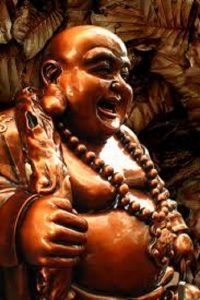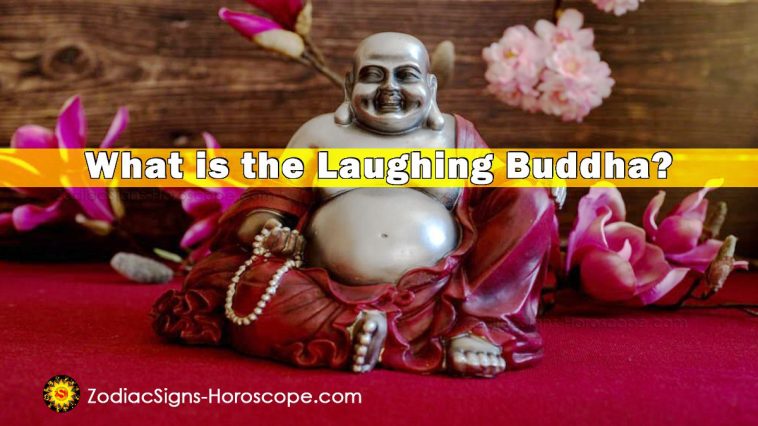What is the Laughing Buddha?
There are many different types of Laughing Buddha. He may be surrounded by children (as mentioned earlier) or holding a hempen or cloth sack. The statue where children surround him is intended to bring blessings and luck to all areas of life.
If someone says the name “Buddha,” just about everyone can picture the same or a similar image in their brain. He is a man in a seated position, a position for meditation. It’s the image of Buddhism and happiness, synonymous with ancient China and enlightenment.
Buddhism and Feng Shui
Buddhism is tied with feng shui, meaning ‘wind’ and ‘water,’ and it is the order to bring good luck and prosperity.
Interestingly enough, many Buddhas are depending on the school of Buddhist thought. A Buddha is someone who has reached enlightenment and has liberated themselves from suffering by exiting the constant cycle of birth and death or samsara. They will not be reborn or reincarnated.
But, in another school of Buddhist thought, there is only one Buddha per age. And the current Buddha of our age is what we all think of when someone says the name.
He is the man who lived centuries ago, became enlightened, and founded the basis of Buddhist beliefs and teachings. This Buddha is named Gautama Buddha or Shakyamuni Buddha. He was a young prince in India and became disgusted with sickness, death, and poverty in the world and decided to leave his life to pursue enlightenment.
So, Buddhism began in India, eventually spread through trade routes to the Far East, and became especially popular in China, Korea, and Japan.
Schools of Buddhism
Buddhism has two significant schools of thought: Theravada (The Way of the Elders) and Mahayana (The Great Vehicle). Theravada is mainly practiced in Southeast Asia and requires that its followers become monks who spend their lives trying to reach nirvana.
Mahayana is practiced in eastern Asia and allows even the “common folk” the chance to achieve salvation, and other enlightened beings can help them to do so.
The Hotei Buddha, or “The Laughing Buddha”
The Hotei Buddha, or “The Laughing Buddha,” as the article title names, is not the former Indian prince we all know. This Buddha comes from Chinese folklore originating in the 10th century. Hotel is the Japanese name for this man, and Pu-Tai or Budai is the Chinese name.
It is the story of a jolly monk named Ch’i-Tzu who lived in Zhejiang and was much loved. Before he died, he shared that he was the incarnation of the Maitreya Buddha, who was to be the Buddha at a later age. This story of Ch’i-it eventually spread from China to Japan and other parts of Asia, and his name became Putai (Budai), which means “hempen sack.”
He is sometimes shown with children and carrying a pack of sweets for the children.
The Laughing Buddha and Prosperity
The Laughing Buddha aims to bring happiness, generosity, abundance, and protection to the young, the poor, and the weak. This Buddha is usually found outside of a Chinese temple. It is common to rub the Hotei Buddha’s stomach for good luck when entering the Buddhist temple.
In feng shui, the ancient Chinese art of structuring one’s surroundings to encourage harmony and positive energy Chi flow, it is essential to add proper accessories to one’s home and workplace to achieve the feng shui goals. In the Chinese culture, as opposed to a Western viewpoint, luck and success should be encouraged and worked for.
Placement of Laughing Buddha
Surroundings can be adjusted and manipulated to evoke positive vibes, energies, and occurrences in one’s life. Including a Buddha in one’s home or workplace can help bring those energies and happenings to the owners and those near. A laughing or Hotei Buddha may be placed in a garden, for example, to bring luck, health, wealth, and happiness.
But, this Buddha must be placed in a proper place easily seen by those who enter, exhibiting honor and respect. It can also be placed within the home in the northwest corner of the house to bring Mentor Luck, the highest of aspirations in the Chinese Buddhist culture.
It will help to bring good career prospects for the head of the house. Not only can it be placed in the home, but it can also be put in the workplace to bring good luck.
Laughing Buddha and Positive Energy
The sack could mean he is taking the worries of the home away. And he is bringing positive energy or that he is bringing riches and abundance to the owner. There is also the Buddha statue holding gold, a pot of gold, or a gold ball or two.

So he is sometimes shown sitting on top of a frog with a coin in its mouth. All of these poses portray and bring wealth and prosperity. The Laughing Buddha statue holds a bowl, bringing general happiness and good luck to the home.
If one wants to encourage spiritual wisdom, a Laughing Buddha will be placed prominently. Lastly, the Laughing Buddha wears a giant hat for a long, happy, and healthy life. All Buddhas always have a smile on their face and always a big belly.
Interesting facts about Hotei Buddha
To sum up, here is a list of seven interesting facts about Hotei Buddha:
1. He is also called “The Laughing Buddha” because of the joyful man he represents.
2. It is the story of a monk from China who claimed to be an incarnation of the Maitreya Buddha.
3. It is a statue of a large man sitting with a large smile.
4.. This Buddha is commonly placed outside Chinese Buddhist temples.
5. Rubbing this Buddha’s stomach is said to bring good luck and is a common custom.
6. The Hotei Buddha brings good luck, health, happiness, prosperity, and abundance.
7. It can be placed in auspicious Places
Feng shui can be a complex art to practice, by adding “Laughing Buddha” can be a good start.


